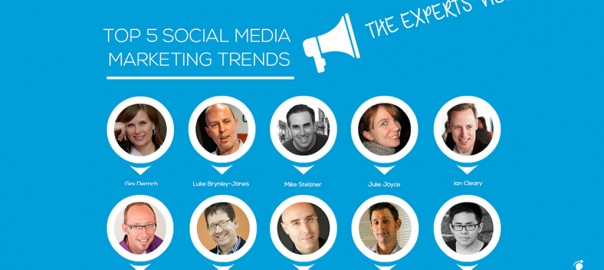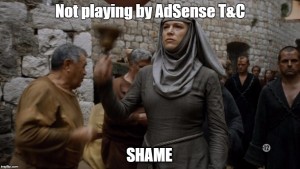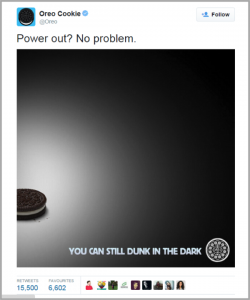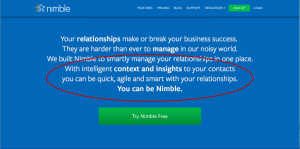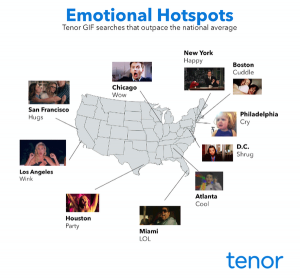As we near the end of another year, the world of social media has once again seen massive changes. With 2015 fast approaching, we asked industry experts what trends they expect to see in 2015 and how those trends will change the way people work in the world of social media.”
1. Converged media is on the rise
Distinctions between paid, owned and earned media will blur. Companies and brands once enjoyed the exclusivity of publication channels they owned, such as their website or blog, while ‘earned media’ meant third parties created and shared content without any affiliation to other outlets, such as advertising. In 2015, converged media will become the norm, where all channels blend into each other. As data streams continue to cross, content will need to work across channels. Companies will need to be alert to the need for consistent proactive messaging, and co-ordinated, uniform reaction, to support campaigns, drive engagement and handle crises.

“With the decline in reach for posts by Facebook Pages (due to many factors but sheer volume of Posts and Pages Liked is significant), smart marketers will need to use a combination approach to reach more fans on Facebook. For example, sharing on Twitter a video or image your brand posted to Facebook can add value to the Facebook post. Marketers will need to find ways to weave together and drive social traffic from one network to another. Gone are the days of “this is our Facebook marketing plan, and this is our Twitter marketing plan.” Brands need to think cohesively about their “Online social marketing plan” that uses their website as the foundation for great content and then integrates cross-social platform sharing to enhance reach and boost engagement from one platform to another.”
Mike Gingerich, Co-founder of TabSite and President of Digital Hill Multimedia @mike_gingerich
 “Converged media is definitely a trend we see. A couple of years ago, we introduced our own PESO model (paid, earned, shared, and owned media) to show how everything we do needs to converge. The organizations and rockstars (both Miley Cyrus and Taylor Swift are masters at this) that are using the PESO model are seeing huge returns, not just in brand awareness and credibility, but in sales and market leadership. Finally we have a way to integrate, to use data for better decisions, and to prove we are an investment, and not an expense.”
“Converged media is definitely a trend we see. A couple of years ago, we introduced our own PESO model (paid, earned, shared, and owned media) to show how everything we do needs to converge. The organizations and rockstars (both Miley Cyrus and Taylor Swift are masters at this) that are using the PESO model are seeing huge returns, not just in brand awareness and credibility, but in sales and market leadership. Finally we have a way to integrate, to use data for better decisions, and to prove we are an investment, and not an expense.”
Gini Dietrich, CEO of Arment Dietrich and author of Spin Sucks @ginidietrich
 “In December 2012, The New York Times published a gorgeous, media-rich article titled “Snow Fall” that documented the events experienced by 16 skiers and snowboarders who found themselves amidst a deadly avalanche. No bit of media was spared from the piece; photos, videos, gif animations, audio files, slideshows, CGI, satellite imagery, historical images, and user-generated content were masterfully woven together to give readers a stunning, first-of-its-kind glimpse at the future of converged media in storytelling.
“In December 2012, The New York Times published a gorgeous, media-rich article titled “Snow Fall” that documented the events experienced by 16 skiers and snowboarders who found themselves amidst a deadly avalanche. No bit of media was spared from the piece; photos, videos, gif animations, audio files, slideshows, CGI, satellite imagery, historical images, and user-generated content were masterfully woven together to give readers a stunning, first-of-its-kind glimpse at the future of converged media in storytelling.
“Snow Fall” went on to earn The New York Times both a Webby Award and a Pulitzer Prize, but similar follow-on productions by both news agencies and marketing firms have been far and few between. Why? Because it took 1) armies of developers and 2) massive amounts of time for The New York Times to produce “Snow Fall”; spare hands and time are two resources that most news outlets and marketing groups do not have in abundance. So how will this change in 2015? The use of code-free or code-minimized web builders, site platforms like WordPress, and apps like Scroll Kit, which combined, enable the creation of “Snow Fall” like projects by a single person in under an hour, will reach an adoption tipping point in 2015, at which point we will see an “avalanche” of converged media.”
David Gerzof Richard, President & Founder of BIGfish PR, rofessor of Digital Marketing at Emerson College in Boston, a contributor to Entrepreneur Magazine, an angel investor and a regular lecturer on digital media and marketing at Harvard University@DavidGerzof
2. Social advertising will increase
The organic reach of content published on corporate Facebook pages will continue to decline, while spending on social networks continues to rise, some forecasts say to $ 11 billion dollars by 2017 in the US alone. Social networks will become more of a one-stop-shop, where people continue to connect with friends while increasingly checking out companies, products and campaigns. If brands are to hold the viewer’s attention, they must put edgy, high quality content front and spend money on social media advertising.

“Clearly content marketing is already underway. Facebook has made it very clear that it will be demoting promotional posts. This means marketers who have something to sell on Facebook will be forced to use Facebook ads.”
Mike Stelzner, CEO and Founder of Social Media Examiner

“I agree: Social advertising will increase to make up for the decline in organic reach. Businesses will need to pay to get their content seen. There is no avoiding this. As social media becomes more and more pervasive in our day-to-day lives, more people will join and use social media, hence increasing the volume of content on these networks. This will cause organic reach to fall as there is so much competition for content. To make up for it, we can definitely expect social advertising to play a more important role. The idea of ‘free’ social media will soon vanish and social advertising will be a norm for businesses who want to take social media seriously.”
Aaron Lee, Grand Master of Customer Delight at PostPlanner @AskAaronLee

“Social Advertising will see significant growth next year on Facebook and other platforms. An example is Twitter. At the moment Twitter doesn’t restrict the tweets coming from your followers but that means there is far too many tweets, so you end up not seeing most of the content. To make your content stand out you need to advertise. When brands are doing their budgets for next year they will be allocating more money to social advertising and will take budget from traditional advertising to pay for it!”
Ian Cleary, Tech Blogger on RazorSocial, Contributor, Social Media Examiner, VentureBeat @IanCleary
3. Growing need in image tracking
Instagram became the most important social network for teenagers in the United States in just two years, rising from 12% in the fall of 2012 to 30% by spring 2014, while Facebook’s popularity fell from 42% to 23% in the same age group. The number of images uploaded and shared with other users has been rising constantly and is nearing two billion per day. The message is simple – images and videos are more appealing than plain text, on established social networks and emerging ones focused on image-based content. Viral video will only rise in importance, and the more emotional the better. As the number of photos rises, so does the need for image tracking.

“Photos capture what people are most passionate about, but for some products a large majority of posts have no text reference to relate back to their brands. Marketers should track the geographic footprint of their products and brands and analyse consumer behaviour via photos as well.”
David Rose is the CEO of Ditto, a visual recognition engine that discovers photos with products and brands and makes those photos actionable for marketers @davidrose
 “When it comes to digital, we will have winners and losers (like everything else). The winners in digital are, without question, images that are social, mobile and fast. With that, we will need much better (and more robust) monitoring, tracking and analytics tools. These channels are blurring the lines between organic and paid content. And, as brands spend more and more time (and money) in these spaces, the large sums of dollars will need better substantiation along with better tools for optimization.”
“When it comes to digital, we will have winners and losers (like everything else). The winners in digital are, without question, images that are social, mobile and fast. With that, we will need much better (and more robust) monitoring, tracking and analytics tools. These channels are blurring the lines between organic and paid content. And, as brands spend more and more time (and money) in these spaces, the large sums of dollars will need better substantiation along with better tools for optimization.”
Mitch Joel is President of Twist Image and professional speaker and columnist on topics of marketing @mitchjoel
4. Proximity marketing will break through
The desktop will give way to the portable device. Technology will continue to evolve and change the way we consume media. Permanently ‘on’ smartphones and tablets are everywhere and enable users to be online at all times. It is therefore not surprising that the time spent using the Internet and mobile devices has risen as well as the spending on advertising, while consumption time has decreased for print, radio, and TV. According to a 2013 study, mobile advertising in the US is a 30-billion-dollar market. With the change in how we use the Internet – from limited time spent at a computer in a fixed location to being online almost everywhere we go – changes in advertising towards localization are inevitable if brands want to keep up with their users.

“Proximity marketing has the potential to be hugely powerful, especially when combined with data from your social graph, which can make locations more personal and relevant. But it’s been around for a long time – I planned a bluetooth proximity campaign for a mobile social network in 2008 – and it still hasn’t broken through into mainstream marketing. I don’t see that changing in 2015.”
Luke Brynley-Jones, founder and CEO of Our Social Times, the UK-based social media agency @lbrynleyjones
5. Content and connection-based networks will merge
The selling point of some networks, especially business networks such as LinkedIn, was connection rather than content. It was less about what people post and more about who knows whom. In the recent past, however, many networks have taken to integrating both into their platform. Content- and connection-based networks are gravitating towards each other, with each one becoming more similar to the other one step at a time.

“I especially think that content and connection based networks are gravitating towards each other. I’m seeing more amazing marketers writing posts on LinkedIn rather than on their blogs or an industry site, for example. With the massive flood of content out there, I think that it’s much easier to get to what you want when you’re seeing something coming from your connections that you trust, so for me, that’s definitely how I plan to get a lot of my information in 2015.”
Julie Joyce is the owner of the link building company Link Fish Media and one of the founding members of the SEO Chicks blog @JulieJoyce
“LinkedIn will continue to develop its highly successful blogging feature into a full-blown content network, offering more formats – including video and presentations (i.e Slideshare) and with more advertising options.”
Luke Brynley-Jones
Thanks to all our experts for answering the questions Talkwalker’s own Julie asked them about the future of social media! We’re excited to see what 2015 will bring in new developments in social media and how our experts’ predictions will turn out. How about you? What do you expect to see in the coming year?
Digital & Social Articles on Business 2 Community
(437)
